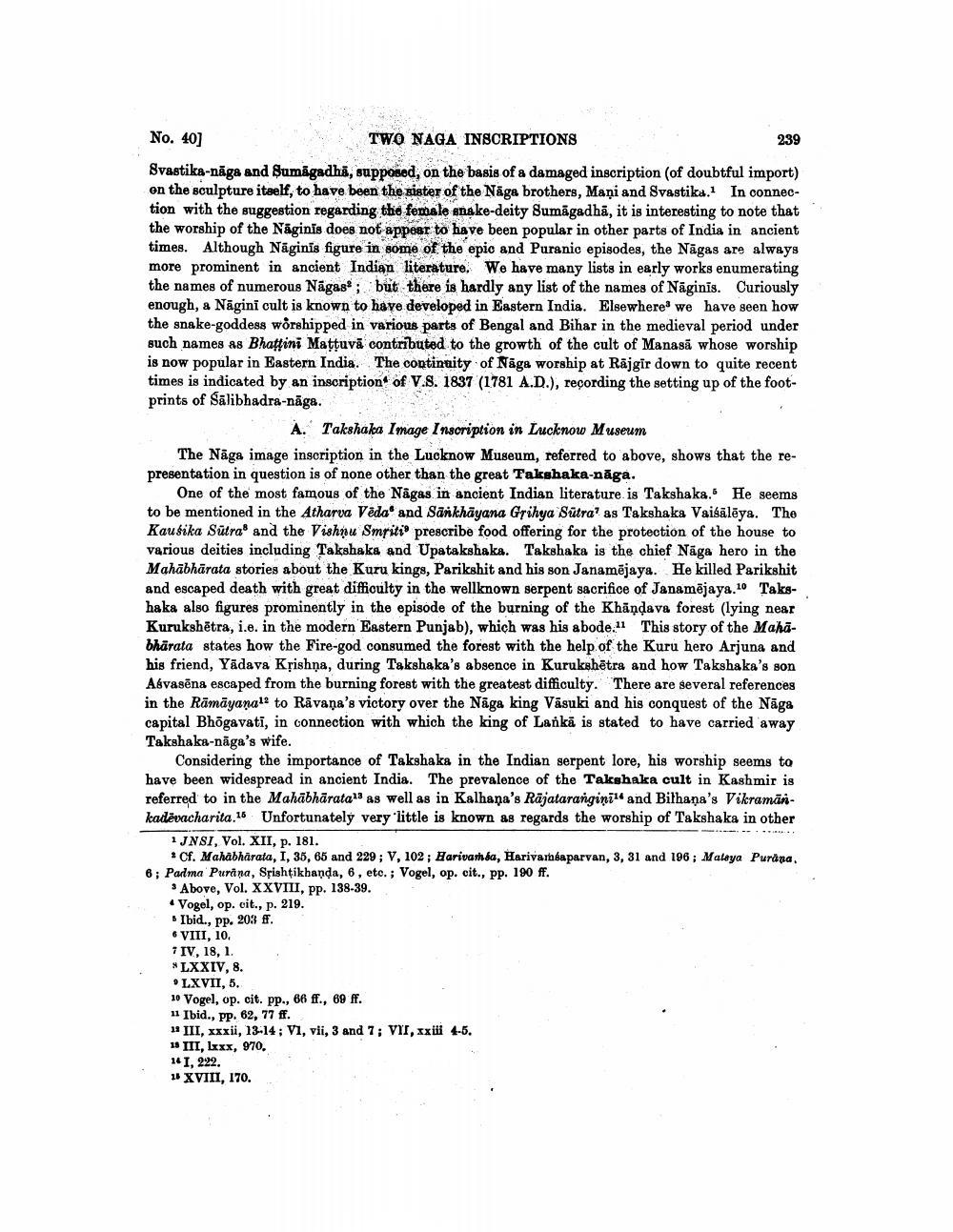________________
No. 40]
TWO NAGA INSCRIPTIONS
239
Svastika-näga and Sumāgadha, supposed, on the basis of a damaged inscription (of doubtful import) on the sculpture itself, to have been the sister of the Näga brothers, Maņi and Svastika. In connection with the suggestion regarding the female snake-deity Sumāgadhā, it is interesting to note that the worship of the Näginis does not appear to have been popular in other parts of India in ancient times. Although Nāginīs figure in some of the epic and Puranic episodes, the Nāgas are always more prominent in ancient Indian literature. We have many lists in early works enumerating the names of numerous Nāgas; but there is hardly any list of the names of Nāginīs. Curiously enough, a Nāgini cult is known to have developed in Eastern India. Elsewhere we have seen how the snake-goddess worshipped in various parts of Bengal and Bihar in the medieval period under such names as Bhattini Mattuvā contributed to the growth of the cult of Manasā whose worship is now popular in Eastern India. The continuity of Nāga worship at Rajgir down to quite recent times is indicated by an inscription of V.S. 1837 (1781 A.D.), recording the setting up of the footprints of Salibhadra-nāga.
A. Takshaka Image Inscription in Lucknow Museum The Nāga image inscription in the Lucknow Museum, referred to above, shows that the representation in question is of none other than the great Takshaka-nāga.
One of the most famous of the Nägas in ancient Indian literature is Takshaka. He seems to be mentioned in the Atharva Veda and Sankhāyana Gyihya Sutra? as Takshaka Vaisālēya. The Kausika Sutra and the Vishnu Smriti prescribe food offering for the protection of the house to various deities including Takshaka and Upatakshaka. Takshaka is the chief Nāga hero in the Mahābhārata stories about the Kuru kings, Parikshit and his son Janamējaya. He killed Parikshit and escaped death with great difficulty in the wellknown serpent sacrifice of Janamējaya.10 Takshaka also figures prominently in the episode of the burning of the Khāndava forest (lying near Kurukshētra, i.e. in the modern Eastern Punjab), which was his abode.11 This story of the Mahabharata states how the Fire-god consumed the forest with the help of the Kuru hero Arjuna and his friend, Yādava Kșishna, during Takshaka's absence in Kurukshētra and how Takshaka's son Akvasēna escaped from the burning forest with the greatest difficulty. There are several references in the Rāmāyanal2 to Rāvana's victory over the Nāga king Väsuki and his conquest of the Nāga capital Bhögavati, in connection with which the king of Lankā is stated to have carried away Takshaka-nāga's wife.
Considering the importance of Takshaka in the Indian serpent lore, his worship seems to have been widespread in ancient India. The prevalence of the Takshaka cult in Kashmir is referred to in the Mahābhārata") as well as in Kalhana's Räjataranginiai and Bithana's Vikramänkadēvacharita. 16 Unfortunately very little is known as regards the worship of Takshaka in other
1 JNSI, Vol. XII, p. 181.
* Cf. Mahabharata, 1, 36, 65 and 229; V, 102; Harivansa, Hariyambaparvan, 3, 31 and 196 ; Malaya Purära. 6; Padma Purana, Srishtikhanda, 6, etc.; Vogel, op. cit., pp. 190 ff.
3 Above, Vol. XXVIII, pp. 138-39. Vogel, op. cit., p. 219.
Ibid., pp. 203 ff. . VIII, 10. 7 IV, 18, 1. * LXXIV, 8.
LXVII, 5. 10 Vogel, op. cit. pp., 66 ff., 69 ff. 11 Ibid., pp. 62, 77 ff. 12 III, Xxxii, 13-14; V1, vii, 3 and 7; VII, axii 4-5. 15 III, Lxxx, 970. 141, 222. 15 XVIII, 170.




